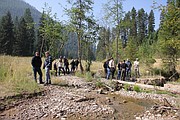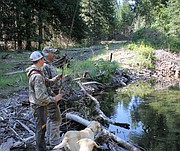Flat Creek fish habitat improvement focus of group
Just downstream from where a group of county and state agency officials had stopped to examine the work done on Cedar Creek was Superior resident Shawn Plakke, who was teaching his 13-year-old son, Orion, how to fly fish. A deep pool, created by logs installed last year through a habitat improvement project, yielded a school of 6-inch cutthroat trout. Trout that Orion skillfully pulled to shore after landing his fly on the still, clear water surface.
After pulling the small trout to shore, he released them back into the pool. Where eventually they will make their way to the Clark Fork River. The Cedar Creek Project done by Trout Unlimited and the U.S Forest Service has been proven a success. A recent fish survey shows the number of cutthroat trout increased seven times higher going from less than 10 per 100 meters to nearly 70.
This is something members from the Department of Environmental Quality (DEQ), Fish Wildlife & Parks, the Forest Service, and Trout Unlimited want to see happen as work continues on Flat Creek located four miles northeast of Superior.
These representatives, along with members from the Mineral County Soil Conservation Board, community members and other agency representatives gathered last Friday along the banks of Flat Creek to discuss future plans. The Flat Creek-Iron Mountain Mine has been a Superfund site since 2002 and contained elevated levels of arsenic, lead and antimony. The tailings are the result of silver mining activity which started in the late 1880s, and later other minerals were mined from the site.
Water quality is what DEQ is focusing on cleaning up, the second piece is the habitat, explained Fish, Wildlife & Parks fisheries biologist Ladd Knotek. “DEQ is doing what they are mandated to do, and they are doing a great job. That’s where we want to partner with them and do the next piece, which is the habitat,” he said.
By working to put in wood and create natural pools including overhead wood, undercut banks and plant vegetation, “all the stuff that makes it a natural stream. That’s the part DEQ is not funded to do and that where we can step in,” he said.
THE POINT of the tour was to bring various departments together and look at the current plans, point out any red flags that may appear, and determine what needs to be done in the future.
“This is an important fishery and is impacted by the work that has been done. The ultimate goal is to expand on that habitat,” Knotek said.
Jim Lommen, who sits on the Soil Conservation Board in Mineral County, questioned why all of the trees and vegetation were removed from the area. It’s something that violates the 310 Rule which prohibits removing vegetation along stream and river banks.
DEQ Project Manager Joel Chavez, along with county planner Tim Read, explained that the tailings didn’t just include giant rocks but also fine grain that needed to be dug out close to the creek. In order to get all of the contaminated material, trees and other vegetation needed to be removed. A lot of the trees and vegetation were also contaminated and needed to be disposed of in the repository. Trees that were not contaminated were sent to the Tricon Lumber Mill.
Unfortunately, spring flooding washed away seed and soil this spring before vegetation could take hold and keep things in place. Sediment could be seen washed into the Clark Fork River, but it was not contaminated soil, Chavez explained.
Another concern brought up during the tour is when the stream dries up during the summer months, the fish can’t reach the Clark Fork River. The fish “pool up” in the deeper areas of the stream until the water rises and then they make their way into the river.
“These tributaries are important nurseries for the fish,” said Fish, Wildlife & Parks Fish Manager Pat Saffel. “All of these are important to the fishery of the Clark Fork River collectively. However, some are more important than others,” he said.
THERE ARE two major areas the group focused on. The area close to the mine is where the massive tailings were located and required the removal of nearly all vegetation. This is the area owned by the Montana Environmental Custodial Trust.
The lower two miles of the creek are owned by the Forest Service where contamination is not as bad and there are pockets of disperse tailings among the trees. Trout Unlimited and the Forest Service will work together along with DEQ to remove these pockets and minimize the disturbance to the stream.
Knotek handed out graphs which showed the potential for the fish in Flat Creek, as well as the success they had from treatments done on Cedar Creek which is located on the south side of Superior below Missoula Lake.
Cedar Creek is an ideal nursery for cutthroat and bull trout due to its colder water and was treated last year. Trout Unlimited worked with the Forest Service and built up the creek with wood cuttings and rock along with vegetation including willows. The project also involved moving the main road a few yards toward the mountain which opened up another channel for the creek during high waters.
“You can see how the sand and soil is built up behind the logs that had been put here,” said Rob Roberts with Trout Unlimited, as he picked up a handful of soil at Cedar Creek. “This is what Flat Creek will start to look like by next year.”
With Flat Creek, after the area is treated and the habitat improved, they hope to see three times as many fish including native cutthroat trout along with brook trout. Currently, according to the fish survey, there are 22 fish per 100 meters. After treatment they are expecting 64 fish per 100 meters.
“As time went on with mining activities, the stream turned into a ditch and it lost its value as a fishery,” Knotek said. “Simplified channels have less water and obviously fewer fish. By creating pools it provides more habitat for them. We want to provide value on top of the clean water and restore this stream to what it used to be in the 1800’s.”
HOWEVER, NOT everyone is happy with the stream work. Jim Schultz, who is one of the few people who live up Flat Creek, has been opposed to the project from the beginning.
“Nobody uses Flat Creek, it’s not an important fishery. I don’t feel it’s worth the effort with all the money spent on this. I question the contamination’s transference to humans,” he said, having raised his family on the creek. His wife’s family had bought property in the area in 1939, and though several family members had various forms of cancer, he said there is not proof that it was the stream that caused it. “I have an aunt in Portland who has cancer and she has never been here. We don’t know what causes it,” Schultz said.
However, Roberts said Trout Unlimited works with mine reclamation projects all over the place and feels that removing serious contaminants is goal number one. Also, since the equipment and workers are already there, why not marry up those efforts with improving the stream at the same time?
“Local residents and agencies care about these places more than you might think. They live here and recreate here and they know the area. It might just be another project for DEQ, but everyone recognizes that it impacts the community and its residents,” Roberts said.





